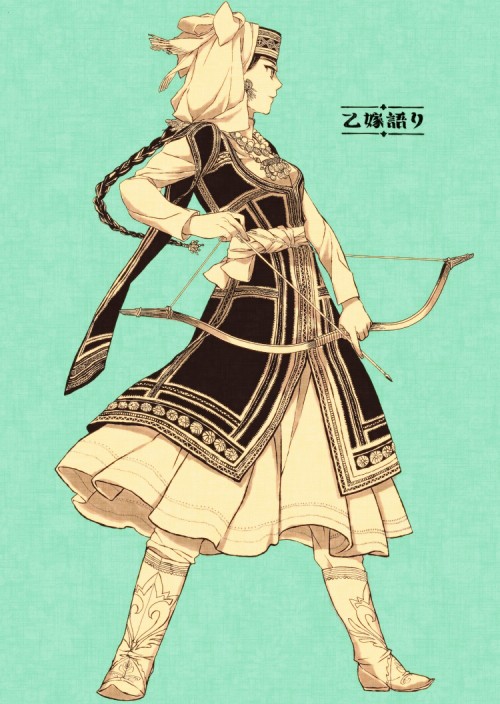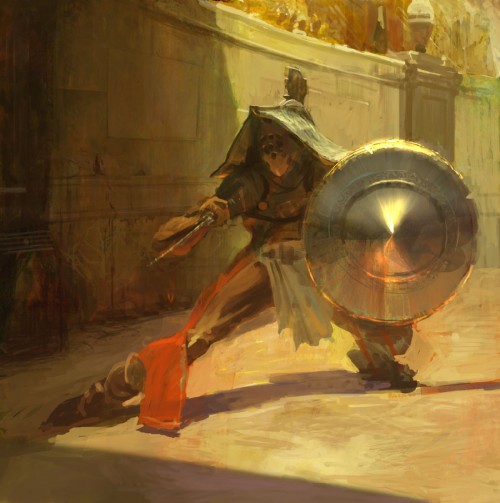In which we attempt to make a Druid whose focus is on archery for Fifth Edition Dungeons & Dragons
Let’s delve into a spellcasting class and do something a little different with it, shall we? Let’s take our favorite pointy-eared friends with Longbow proficiency and a bonus to Wisdom, the Wood Elf, and see if we can’t come up with a bow-wielding Druid that works reasonably well.
Racial selection is pretty simple. Wood Elves are thematically appropriate, they bring proficiency with the best ranged weapon to the table, they get a +2 bonus to Dexterity (nice for the bow) and a +1 bonus to Wisdom (nice for Druid spellcasting). For stats we use the standard Heroic array and place the 15 in Wisdom, 14 in Dexterity, 13 in Constitution, 10 in Strength, 8 in Charisma. After our racial modifiers we get a statline of Str 10 Dex 16 Con 13 Wis 16 Cha 8.
For a background let’s take Hermit. This isn’t a charismatic elf, so a solitary life surrounded by nature seems about right. This grants proficiency in Nature and Religion and a bevy of story-driving background hooks. As a Wood Elf we’re already proficient in Perception, so for our last two skills we select Animal Handling and Survival from the Druid list.
At first level we gain the Druidic language. Hooray. More importantly we gain spellcasting. We know two cantrips and can prepare four spells at a time. Cantrip selection is important. Guidance can make our ranged attacks more successful, so we definitely pick that up. Mending lets you get all your arrows back at the end of a fight and can be generally useful for fixing other things. Interesting 1st level Druid spells for an archer include Entangle, Jump, Longstrider, and most particularly Faerie Fire. Cast Faerie fire on a group of enemies and watch your allies fall in love with you.
At second level we gain Wild Shape and Druid Circle as class features. Wild Shape has a fair amount of utility, but we won’t be using it in combat. Bears don’t shoot bows, last I checked. They prefer to use polearms. Selection of a Druid Circle is fairly straightforward. The Circle of the Moon offers better combat-capable Wild Shape use. But we don’t care about Wild Shape in combat, so we select Circle of the Land. We get initiated in the Grasslands for reasons of spell selection and because archers thrive on the open steppes. Ask the Parthians. Or the Huns. Or the Mongols. This level the Circle of the Land grants us a Wizard-like ability to recover some of our spell slots as part of a short rest. It also grants us a third known cantrip. At this point we should know Druidcraft, Guidance, and Mending. Not a game-breaker, but nice.
At third level we gain access to 2nd level spells. As a Grassland Druid, we gain Invisibility and Pass Without Trace on our spell list, always treated as prepared, and available to cast normally. How handy Invisibility might be to an archer should be self-evident. Other 2nd level spells on your list include Enhance Ability (which doesn’t actually improve your ability score, but grants advantage), Heat Metal, and Spike Growth. You also gain a fourth cantrip. Let’s take Thorn Whip.
The fourth level we get our first feat or ability score bump. Sharpshooter is extremely tempting here. To avoid range and cover penalties we pick it up. With only a +5 to attack with a bow, taking a -5 to hit for a +10 to damage is something that would rarely be worthwhile at this point, but the option is there. We also get an improvement to Wild Shape, being able to take CR 1/2 forms, including those with swim speeds. Potentially very useful.
At fifth level all our Ranger and Fighter buddies just got their second attack. We’re super jealous, but our Druid Circle selection gets us Daylight and Haste. Why might we be interested in getting Haste? Hmm. A mystery. Other 3rd level spells we may find interesting include Dispel Magic and Wind Wall.
At sixth level we gain Land’s Stride, allowing easier movement through non-magical rough terrain. This may be good for getting into an advantageous position.
At seventh level we gain access to fourth level spells, including Divination and Freedom of Movement. Other fourth level spells we may find interesting are Grasping Vine and Stone Shape.
At eighth level we finally get off our butts and improve that Dexterity score to 20. We attack once per round at +7 for 1d8+4 damage with a longbow, various means of assuring advantage on our attacks, pinning opponents in place, deterring them from closing into melee with us, and otherwise supporting our allies. We may also use Wild Shape to take CR 1 forms, including those that can fly.
At ninth level we get fifth level spells and our last round of Circle Spells in the form of Dream and Insect Plague. Neither of these are particularly on-theme for our bow-wielding Druid. Other fifth level spells of interest are Contagion, which is insanely good and should be house-ruled or tamed by errata of some sore, and Scrying. Our proficiency bonus bumps up to +4, and we are now at a point where using Sharpshooter for extra damage is frequently a reasonable choice.
At tenth level we gain a fifth cantrip. Considering how hard some things hit at these levels, Resistance can be a life-saver. We also gain immunity to poison and disease. We’re also immune to charm and fear from fey creatures, which I suppose is good for some campaigns.
At eleventh level we gain access to sixth level spells, and most D&D campaigns are winding down or rapidly approaching climax. Take a look at Conjure Fey. Then look through the Monster Manual at what some of the creatures you can summon are capable of doing. Then scratch your head and wonder why you wouldn’t want a little of that in your life.
At twelfth level we bump Wisdom up to 18. Will we ever top off an attribute at twenty? Odds are we’ll never see level 16, so no. The DC to resist our spells stands at 18. We attack with our Longbow at +8 for 1d8+4 damage twice per round with Haste (which we can cast 3 times per day at 3rd level, nine times tops). We may optionally attack at +3 for 1d8+14 due to Sharpshooter. We have several ways to gain advantage for ourselves.
By way of comparison, a Battle Master Archer attacks three times per round, all day every day, with a 15% higher chance to hit and a hair more damage, with a few handy tricks for making those shots have tactical effects. She can’t, however, turn into a flying venomous serpent twice a day.
| Archer Druid | ||||||||||||||||||||||||||||
|---|---|---|---|---|---|---|---|---|---|---|---|---|---|---|---|---|---|---|---|---|---|---|---|---|---|---|---|---|
| Wood Elf Druid (Circle of the Grassland) 12 Hermit Background Chaotic Earthy
Skills:Animal Handling (8), Nature (5), Perception(8), Survival(8), Religion(5) |
Please feel free to use in your own adventures, with or without attribution or even remembering where you got the idea. Games are made to be played.


